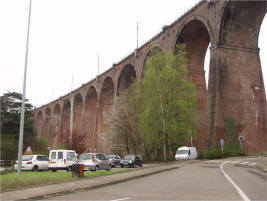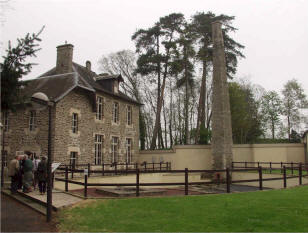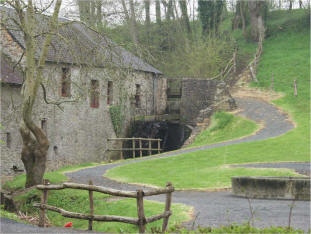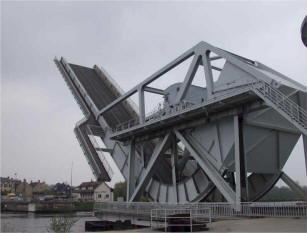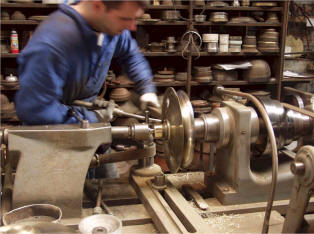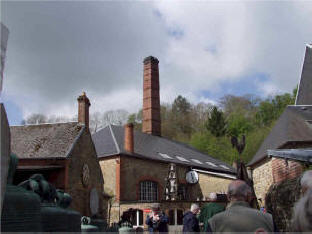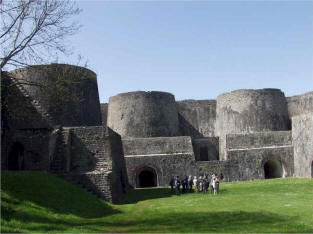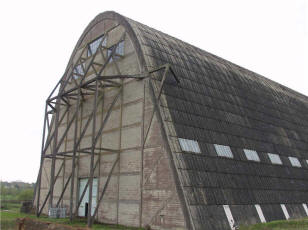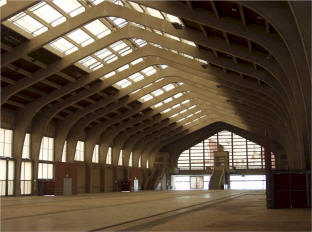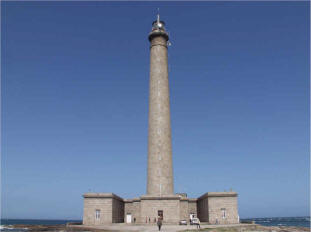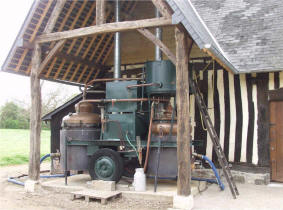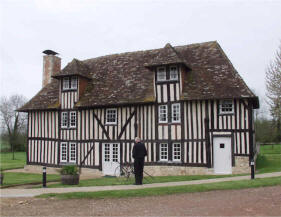|
NOT A YEAR IN PROVENCE - BUT FIVE DAYS IN NORMANDY! 21st - 25th April 2008 |
|
Monday 21 April dawned cool, misty and damp in London as twenty-six Newcomen Society members and their guests joined the coach near Victoria for the Newcomen Society’s Spring Meeting in Lower Normandy. Everyone arrived on time and we were soon on our way to Dover to take the ferry. After a smooth crossing, a drive of three hours or so took us to the Barentin viaduct near Rouen. This is a large brick viaduct, on a curve, carrying the Rouen-Le Havre railway about 100 feet above a valley. The viaduct is 600 yards long, has 27 arches and is a monument to 19th Century British civil engineering. Completed in 1845 by Thomas Brassey and William MacKenzie to the design of Joseph Locke, the original structure collapsed, after several days of heavy rain, on 10 January 1846. The true cause of the collapse remains unclear but the poor quality of local lime used in the mortar became a leading candidate for blame and it is noteworthy that Messrs Brassey and MacKenzie rebuilt the viaduct at their own expense using lime of their own choice. Having paid due homage to the statue of Locke beneath the viaduct, we continued to our hotel, conveniently situated in the centre of Caen. |
|
Barentin Viaduct |
|
Tuesday morning found us at the Musée de la Mine at Le Molay Littry. This museum has been created on a mine site in an extensive coalfield to the west of Caen, first exploited between 1744 and 1749, when the first mining company in France, La Compagnie des Mines de Littry was formed. The Littry coal, however, was of poor quality and was chiefly used to fuel lime kilns. La Compagnie des Mine de Littry was dissolved in 1879 and the mines were finally abandoned the following year. The Museum was founded some twenty years later and houses extensive collections relating to the local mining activity. Perhaps the most important exhibit is a steam winding engine built in 1800 by the brothers Périer, to what seems to be a rather complicated design in which wood is the predominant structural material. It is reckoned that, by 1810, over 40 of these engines were at work in France; of which the Littry engine is the only survivor. From the Musée de la Mine, we went on to visit the nearby Moulin de Marcy, a small watermill in an idyllic rural setting, which has been a museum since 1986. While much of the machinery was familiar, there were some interesting differences of detail, including special ‘stones’ studded with small metal plates set edge-on, which appeared to be used for grinding grains not commonly seen in English mills. There was also an oil engine in an outhouse, presumably to provide power for the mill during droughts.Tuesday afternoon was devoted to sites associated with the D-Day invasion of 6 June 1944. Our first call was at Arromanches. Disappointingly, the high tide and poor visibility meant that little could be seen of the remains of the Mulberry Harbour, the subject of the 1990 Dickinson Memorial lecture by Sir Alan Harris. We did, however, visit the Debarquement Museum to view the Mulberry Harbour models and other relics of the invasion. A short drive took us to Pegasus Bridge, which no longer spans the Caen Canal but has been moved bodily into an adjacent field as the centre piece of a museum devoted to the extraordinary glider-borne assault which enabled British soldiers to capture the bridge with relative ease. Also at the museum is a full-scale replica Airspeed ‘Horsa’ glider, built from the original drawings by French enthusiasts. |
|
Le Molay Litry Moulin de Marcy
Current Pegasus Bridge |
|
Villedieu-les-Poeles is renowned in Normandy as a centre of copper and brass working. Our first visit on Wednesday took us to l’Atelier du Cuivre, one of the older workshops still active in Villedieu, where we saw copper pans and other objects being made by traditional methods, including spinning. We also learned how to tin the inside of a copper pan but l’Atelier maintained strict silence as to how the rivets for securing pan handles were attached with nothing being visible inside the pan. Further along the street stands the Fonderie des Cloches, one of the two remaining bell foundries in France. The casting of bells uses techniques tried and tested over many years and we saw the various processes used to create the moulds for bells and the century-old double-arched reverberatory furnace in which the bell metal is still melted, as well as the machine tools used for the final tuning of bells. We spent Wednesday afternoon at Regnéville, a former port at the mouth of the River Sienne. As a port, Regnéville relied on the extensive beach uncovered by its high tidal range to allow ships to load and unload and it was also much used for cleaning ships’ hulls, as the beach was dry for six hours out of every twelve. A little way inland, the Musée de Regnéville is situated next to a complex of four monumental lime kilns which, when seen from a distance, resemble a mediaeval fortification. The Museum tells the story of Regnéville and its one-time maritime trade. The history of the lime kilns, which were reckoned to be capable of producing 100 tons a day of quicklime is also related; much of the lime was exported by sea as well as being taken inland by cart. Changes in maritime practices, the increasing size of ships and the decline in the usage of lime eventually led to Regnéville becoming the peaceful spot it is today. |
|
Villedieu Copper Working Villedieu Bell Foundry Regnéville Lime Kilns |
|
Thursday morning began with a visit to a World War 1 airship hangar at Ecausseville, a village near Cherbourg, which is now the only such building in France. The hangar is 150m long and its profile is an inverted catenary with a base width of 40m and a height of 30m; it is built in three sections which are linked but not joined. The structure is of prefabricated reinforced concrete on the Menager System and is clad with Minard type concrete tiles. After several changes of use, the hangar was a French Navy warehouse until 1994 and was recognised as a Historical Monument in 2003. An association of volunteers is now working to preserve the site and develop it as a museum of early aviation.From Ecausseville we travelled into Cherbourg to visit the remaining building of the pre-war Transatlantic Maritime Terminal. This dates from the great days of Cherbourg as a transatlantic liner port and was built in a largely successful attempt to attract more liner traffic. The terminal was damaged during the Second World War; it was subsequently repaired but liner traffic was declining, the rebuilt terminal became a burden for the Chamber of Commerce and large parts were demolished. We visited the train shed, which appeared to have had platforms for four boat trains at once but now houses only a cafe and a few displays. The chief interest is, however, in the building itself, which is of reinforced concrete in a typically 1930s style. Next door, a new exhibition, La Cité de la Mer, dealing with underwater exploration, has been created but our view of this was restricted to looking at the (retired) nuclear submarine which is visible from the quayside. Leaving Cherbourg after lunch, we drove sedately along the meandering road around the end of the Cotentin Peninsula where, on the most north-easterly point, we stopped to see the two lighthouses at Gatteville, 3km north of Barfleur. The smaller and earlier of the two dates from 1774 and has a height of 27m. When its 75m tall neighbour was built in 1836, the older lighthouse was converted to a semaphore tower and it now houses the local coastguard control centre. Some of the more athletic members of our party chose to ascend the 365 steps to the gallery of the newer tower and reported that the views from the top were, indeed, very fine. |
|
Ecausseville Hangar Cherbourg Maritime Station Gatteville Lighthouse |
|
Our journey back to Calais on Friday was broken (some might say ‘lightened’) by a visit to the Calvados distillery of Christian Drouin close to Pont-l’Evêque, where the making of Calvados was explained during a tour of the establishment. An intriguing feature was that, in addition to the fixed distillation plant, Drouin still uses a portable still, which used to be taken to various orchards to produce Calvados on site. No doubt the French excise officers were somewhat relieved when the travels ceased in the mid seventies! There was, of course, the traditional tasting after the tour and several members rejoined the coach accompanied by suspicious clinking noises. From the distillery, we drove into the nearby town (famous for its cheese) for a break and lunch, after which the coach took on a distinctive aroma. On the way from Pont-l’Evêque to Calais, we diverted through the small town of Malaunay, to see another railway viaduct similar to that at Barentin (but without the dramatic history); alas, time did not permit a stop, so we had to view it as we drove by. So we came to Calais, to be blessed by another smooth, if murky, crossing followed by an uneventful drive back to London. |
|
Portable Still Christian Drouin |
|
Report by Clive Ellam,
(c) Newcomen Society, Links
|
|
Heritage of Industry is keen to develop relationships with other societies and associations to mount similar expeditions in France and elsewhere. |

